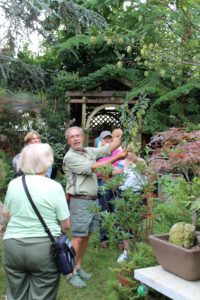Go with the Good Stuff
September 6th, 2016
As we head into the season’s second superb planting window between now and the end of October, we’ll have some decisions to make.

PHS Gold Medal Plant committee member Michael Colibraro shows visitors around his home garden near Philadelphia.
The toughest, in my mind, is which plant is likely to do well in which site.
That takes a lot of experience and intricate plant knowledge, which is why so many people wing it and end up with crappy plants that get bugs, look sickly or flat-out croak.
Most people who live actual lives don’t have the time or inclination to learn whether hosta is a good idea on that hot, sunny bank or whether shrub roses might work out better. (For the record, go with the roses.)
So how can we keep from guessing wrong?
One of the best resources Pennsylvania gardeners have is the Gold Medal Plant program, an arm of the Pennsylvania Horticultural Society – the Philadelphia-based non-profit that runs the world-famous Philadelphia Flower Show.
A panel of about 15 plant experts meets twice a year to talk about superb plants that deserve more use in Pennsylvania yards. I’ve been part of it for 6 years now. We’ll end up giving Gold Medal awards to some four trees and shrubs and four perennial flowers each year.
Since nurseryman Dr. Franklin Styer conceived the idea in 1979, PHS has accumulated what amounts to a 150+-plant all-star team for the mid-Atlantic region.
Winners are listed on the PHS website, and I also have them posted on my site, broken down by trees, shrubs, evergreens, vines and perennials.
The main reason most of these plants aren’t in more yards is that people simply don’t know them. People tend to buy what they know, which is largely the same old familiar dozen or so plants sold cheaply at the box stores.
I’ve seen the big difference plant selection makes in my years of doing Garden House-Calls. I’d argue that starting with superior choices in the first place is what sets apart the best gardeners from the struggling yardeners more than anything else.

Fothergilla ‘Mt. Airy’ was one of my nominations that ended up winning a PHS Gold Medal award.
No matter how much you fertilize or coddle, you’re just not going to get some plants to do well.
The people on the Gold Medal committee have put together careers worth of plant knowledge to help consumers go right to the good stuff.
I always thought that was useful, but once I got a look at the committee from the inside, I value the information even more.
The growers, breeders, authors, public-garden curators, garden-center-owners and horticulturists on the panel really take these choices seriously.
We’ll nominate under-used favorites, then spend hours hashing over the details and viewing specimens of the nominees before putting it to a plant-by-plant vote.
Sometimes a single detriment is enough to derail a nominee. If deer like it or there’s a disease that sometimes takes it down or if it tends to seed around too freely, the plant is likely to go on the reject pile.
There are actually many more plants on that reject list than ones that made the Gold Medal grade, so that should tell you a little about the criteria.
One thing that’s surprised me is how most of the panel members have arrived at similar conclusions – at least when it comes to the “dogs.” See a plant in action long enough, and you find out its Achilles heel (or heels).
So what’s not on the Gold Medal list is almost as telling as what is. Examples: ‘Forest Pansy’ redbud (canker possibility), burning bush (unwanted seeding), ornamental kiwi vine (too aggressive), skimmia (questionable cold hardiness), and ‘Roman Gold’ cedar (not widely available).
The program originally focused on just woody plants (trees, shrubs and conifers), but we’ve added perennials to the mix the last four years.
We just got done picking winners for 2017, and those are listed in the next post here on Sept. 13. That post includes a custom list I’ve developed just for you that offers the best of the Gold Medal winners by their uses.







